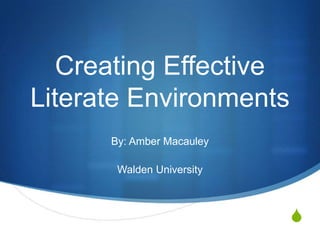
Literate environments
- 1. Creating Effective Literate Environments By: Amber Macauley Walden University S
- 2. Educators can create effective literate environments by focusing on four main aspects: S Getting to know students S Selecting texts S Focusing on the Interactive Perspective S Providing critical thinking and response opportunities
- 3. Getting to Know Students “ It is not what we teach but who we teach.” - Dr. Janice Almasi S
- 4. In order to get to know students, educators must address the cognitive and non-cognitive aspects of each student. Doing so creates a complete picture of student ability level, interest and motivation toward reading and learning.
- 5. Cognitive Assessments S Reading Inventories S Includes word lists, reading passage, series of comprehension questions, and offers retell (Afflerbach, 2012). S Running Records S Assess fluency It is crucial to provide assessment within instructional level to avoid frustration and provide an accurate account of what students CAN do!
- 6. How does this create a literate environment within my classroom? S Able to identify ability and current stage of reading development of each student, which directly affects instructional decisions. S Have identified that my students range from the transitional to the advanced stages of reading development. S Assists with identifying specific needs of each student within the five pillars of reading (phonemic awareness, phonics, fluency, vocabulary, and comprehension). S Example: After administering a running record, I discovered that many students were struggling with decoding CVVC words.
- 7. Non-cognitive Assessments S ERAS- Elementary Reading Attitude Survey (McKenna &Kear, 1990) S Assessment focuses on motivation to read and personal interests S Appealing to young students through the use of cartoon characters.
- 8. How does this help create a literate environment within my class? S Discovered that many struggling readers actually do have a strong motivation to read and drive to improve. S Revealed personal reading interests which includes lots of nonfiction topics. S Addresses confidence level and how students feel about reading aloud in class compared to other students. S As a result, I am able to adapt activities to keep students within their comfort zone.
- 10. While selecting texts, focus on: S Readability S Length S Background Knowledge S Student Interest
- 11. And…….. Select and chart texts throughout each quadrant of Dr. Hartmen’s Literacy Matrix (Laureate Education, 2012a). This ensures that a variety of text is provided based on genre and format. A degree of difficult must also be considered when charting texts. It is crucial to incorporate lots of informational text throughout the early literacy years to avoid the “Fourth Grade Slump”. This ensures that students are prepared in identifying and utilizing differing informational text structures and features (Laureate Education, 2012b).
- 12. Literacy Matrix Linguistic (word oriented) Quadrant 1 Quadrant 2 Narrative Text Informational Text Quadrant 3 Quadrant 4 Semiotic (other than words: pictures, icons)
- 13. How does this help create a literate environment within my classroom? S Able to select and provide texts on a variety of levels ensuring that instruction is provided within the student’s Zone of Proximal Development as identified by Vygotsky. S Incorporate narrative, informational, and web based literature which can provide pictures, video documentaries, and music. S Pay attention to cognitive and non-cognitive aspects when selecting each text.
- 14. Interactive Perspective “ The ultimate goal is to teach children how to be literate learners who can navigate the textual world independently”. -Dr. Janic Almasi S
- 15. The Interactive Perspective is the actual process of teaching students how to read. S It provides an intense instructional interaction between the student and instructor. S Students are taught to be metacognitive learners. In other words, they continuously think about how they think and learn.
- 16. How does this help to create a literate environment within my classroom? S Can provide direct reading instruction in a variety of ways to meet student needs. This includes: S Read Alouds, Shared Reading, Guided Reading, Think Alouds, modeling, and scaffolding instruction (Tompkins, 2010) S Providing these types of instruction allows my students to engage in extended discussion and practice applying new skills with guided support.
- 17. Critical and Response Perspectives “Students need to be willing to share ideas. That’s where learning occurs” -Jackie Stablewski S
- 18. These perspectives… S are crucial for literacy of the 21st century. S provide opportunities for students to think critically about a text and respond to text through a variety of formats. This allows students to make new connections to the world around them.
- 19. Rosenblatt (1978) identifies this connection as a transaction with the text and presents the following analogy. Two clay balls, representing reader and text, collide. This interaction not only changes their course, but leaves a mark, forever changing their identities (Laureate Education, 2012c).
- 20. How do I address the critical perspective within my classroom?
- 21. How do I address the response perspective within my classroom?
- 22. References: Afflerbach, P. (2012). Understanding and using reading assessment, K–12 (2nd ed). Newark, DE: International Reading Association. Laureate Education, Inc. (Executive Producer). (2012a). Analyzing and selecting text [Video webcast]. Retrieved from http://www.courseurl.com Laureate Education, Inc. (Executive Producer). (2012b). Informational text in the early years [Video webcast]. Retrieved from http://www.courseurl.com Laureate Education, Inc. (Executive Producer). (2012c).Response Perspective [Video webcast]. Retrieved from http://www.courseurl.com McKenna, M. C., &Kear, D. J. (1990). Measuring attitude toward reading: A new tool for teachers. The Reading Teacher, 43(9), 626--639. Rosenblatt, L. (1978). The reader, the text, the poem: The transactional theory of the literary work. Carbondale, IL: Southern Illinois University Press. Tompkins, G. E. (2010). Literacy for the 21st century: A balanced approach